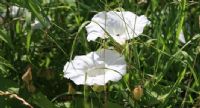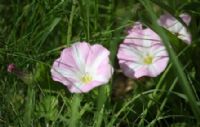

|
|
|
Great Bindweed (Calyistegia Silvatica) Great Bindweed (Calyistegia Silvatica) Date added: 10/08/2021 17:09:34 This plant is short lived and the beauty is in its white trumpet-shaped flowers. However, two of its nicknames suggest its darker side! Gardeners will understand only too well why it has been called “Stranglers with pretty flowers” and “Boa Constrictor”. As a weed it almost defies attempts to eradicate it as it spreads by its roots down to a depth of 9 metres and even small fragments left behind can each start a new plant. Some recommend killing it with vinegar and soap. It is a member of the plant group Convolvulacea and is found in gardens, waste ground and growing up hedges and fences, it has very long stems which may grow up to 20 feet always twisting anticlockwise as it goes upwards. It grows so fast that it can complete one full rotation in only two hours. When it finds no support it scrambles over the ground throttling everything in its path. It is not popular with potato growers as it is a host for potato viruses. In its favour, it is said to be edible (in moderation only as it can act as a strong laxative) and has also been used medicinally in the past, for example by Culpepper, the herbalist, in the 17th century. It was recommended for spider bites. More recently scientists have been researching its possible value in treating cancer. It has antiangiogenic properties which means that it may be useful to inhibit the creation of abnormal blood vessels which enlarge malignant tumours. The flowers are very rich in nectar which the Gatekeeper and Hedge Brown butterflies especially like and there is also a Convolvulus Hawk moth. Relatives found in the Cemetery including C. Septum and the very dainty Convolvulus Arvensis , commonly called Lesser Bindweed, which is pictured inset. Ipomoea or Morning Glory is also related and used to be popular as it contain natural hallucinogens. However, it causes serious side effects such as symptoms of mental health disorders and may even be fatal. Finally you might like to look up ‘Misalliance by Flanders and Swann ‘to find the words of their song about this month’s flower, and even better, listen to it on YouTube. © FNRC
Images related to this news article |
Website designed and maintained by Paul Thompson on behalf of the Friends of Newtown Road Cemetery.


